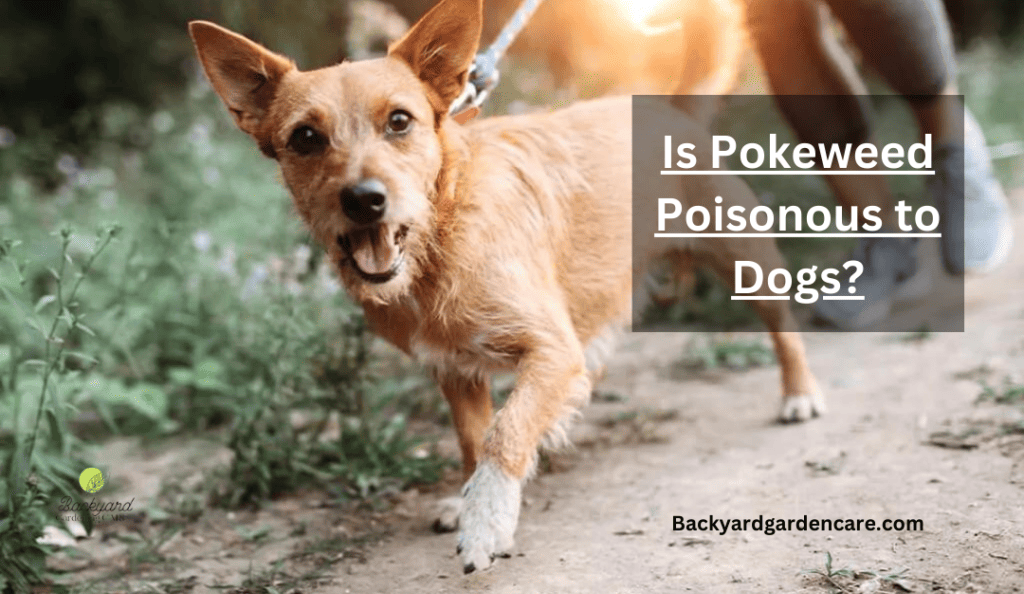Is Pokeweed Poisonous to Touch? Know Everything About Poisonous Plant
Nature offers a plethora of interesting and unique plants, each with its own characteristics and uses. Some are edible and provide nourishment, while others are only decorative.
However, with so many varieties out there, it can be challenging to know which ones are safe to touch or consume. One plant that has been the subject of much debate is pokeweed.
While some swear by its medicinal properties, others warn of its potential toxicity. Pokeweed is considered poisonous to humans and animals. The berries and roots of the plant are the most toxic parts.
Symptoms of pokeweed poisoning include skin irritation, vomiting, diarrhea, Headache, Loss of consciousness, etc. In this blog, we will delve deeper into the world of pokeweed and explore whether or not it is poisonous to the touch.
Let’s get started to discuss whether is pokeweed poisonous to touch.
What is Pokeweed?

Phytolacca americana, commonly known as Pokeweed, is a herbaceous plant that can be found all over the United States. Despite its prevalence and invasive nature, it is crucial to acknowledge that Pokeweed is toxic and requires careful handling.
Let’s explore the potential hazards of touching this plant and understand its toxicity.
Is Pokeweed Poisonous to Touch?
In my opinion, the experience of inadvertently coming into contact with pokeweed has underscored the importance of understanding the potential dangers associated with this plant. Its distinctive dark purple-black berries on bright red stems may catch the eye, but beneath its seemingly harmless appearance lies toxicity.
Handling pokeweed without gloves, as I did for a month without realizing its poisonous nature, can lead to uncomfortable skin irritations and allergic reactions. Crushed berries even induced an itchy sensation in my nose and a peculiar tingling feeling, prompting a moment of concern.
These personal encounters serve as a reminder that pokeweed is indeed poisonous to touch, and it’s essential for people and their pets to exercise caution when encountering this alluring yet hazardous plant.
It’s also worth noting that while pokeweed may be a valuable food source for many birds, this does not extend to humans and pets, who should avoid consuming its toxic berries at all costs.

Let’s explore the potential hazards of touching this plant and understand its toxicity.
The Toxicity of Pokeweed
Triterpene saponins, Phytolaccatoxin, and Phytolaccigenin are toxic compounds in pokeweed. The plant’s poisonous nature comes from these substances, which can hurt people when they ingest or come into contact with it.

It’s important to exercise caution and avoid coming into contact with this plant to prevent any adverse effects on your health.
Avoiding Touching Pokeweed
To stay safe from the harmful effects of pokeweed, it’s crucial to exercise caution and steer clear of any direct contact with any part of the plant. This includes the roots, leaves (both old and new), stems, unripe and ripe berries, as well as the seeds.
It’s important to note that each of these plant parts contains toxic compounds that can have long-term negative effects on human health. Therefore, it’s essential to take all necessary precautions and avoid coming into contact with this plant in any way, shape, or form.
The Consequences of Touching Pokeweed.
When pokeweed comes into contact with bare skin, a rash may develop, similar to the rashes caused by poison oak or poison ivy.
The symptoms of this rash include redness, inflammation, blister formation, intense itching, and the development of blisters on the skin. While milder cases of the rash can be treated at home with proper care, more severe cases may require medical attention.
Understanding Pokeweed Toxicity.
Pokeweed contains toxic substances like Phytolaccatoxin and Phytolaccigenin, which can trigger intense gastroenteritis. Symptoms such as vomiting and diarrhea can occur within two to four hours of consuming it. Snake poison is dangerous due to its potential for causing severe side effects.
The gastrointestinal system also experiences excessive fluid loss, leading to low blood pressure or hypotension. In severe cases, the toxic reaction can result in serious side effects such as weakness, seizures, respiratory depression, and even unconsciousness.
Recognizing the Scientific Evidence.
It’s essential to recognize that scientific studies back up the idea of pokeweed being toxic. Even though Native Americans traditionally used pokeweed for both culinary and medicinal purposes, the current emphasis is on utilizing its healing properties in a safe and efficient manner.
Toxicity as a Defense Strategy.
Numerous invasive plants, including backyard grass and weeds, such as pokeweed, contain toxic substances that protect against animal consumption. Although these plants may not cause animal fatalities, they possess troubling traits that deter them from being consumed.
Finally, pokeweed is poisonous when touched. Various toxic compounds are present in all parts of the plant, and direct contact with your backyard grass, weeds, and pokeweed can cause adverse reactions, especially in people with broken skin.
What Are the Symptoms of Pokeweed Poisoning?
Pokeweed poisoning can lead to various symptoms that can vary in severity. Whether through ingestion or skin contact, exposure to the toxins present in pokeweed can cause adverse effects.
While it may look harmless, pokeweed can poison humans and animals. The plant contains a variety of toxins that can cause serious health problems if ingested.

Pokeweed poison symptoms are listed below.
Stomach Pain: Ingesting pokeweed can lead to intense abdominal discomfort and cramping. These symptoms can either be focused in one area or spread throughout the entire stomach.
Nausea/Vomiting: Pokeweed poisoning can cause various unpleasant symptoms, including nausea and vomiting, which can lead to dehydration and electrolyte imbalances.
It is important to seek medical attention if you suspect you have been exposed to pokeweed or are experiencing any of these symptoms.
Headache: Some people who are exposed to pokeweed may experience headaches. These can be mild or severe and may last for several days.
Diarrhea: Diarrhea is a common gastrointestinal symptom of pokeweed poisoning. Pokeweed poisoning often leads to stomach distress, featuring diarrhea as a prominent symptom. The presence of loose, watery stools and a noticeable uptick in the frequency of bowel movements mark this condition.
Changes in Level of Consciousness: Pokeweed toxicity can have a significant impact on the central nervous system, resulting in a range of altered mental states.
Depending on the severity of the exposure, individuals may experience mild confusion or disorientation or more severe changes in their level of consciousness.
It is important to be aware of the potential risks associated with pokeweed toxicity and to seek medical attention immediately if any symptoms arise.
Incontinence (Loss of Urinary Control): Pokeweed poisoning can have severe consequences, including loss of control over urination, a condition known as incontinence. An increase in the frequency of urination may also mark this symptom. It is important to seek medical attention immediately if you experience these symptoms, as they can indicate a serious condition.
Seizures: In extremely rare instances, exposure to pokeweed can lead to seizures, which are unpredictable and uncontrollable electrical disturbances in the brain. If you experience seizures, it is crucial to seek immediate medical attention.
Difficulty Breathing: Severe poisoning from pokeweed can have serious consequences, including respiratory issues. Severe pokeweed poisoning can lead to respiratory difficulties. Individuals may experience shortness of breath, wheezing, or labored breathing.
It is crucial to seek medical attention as soon as possible if you suspect pokeweed poisoning or notice any symptoms following exposure to pokeweed.
Is Pokeweed Poisonous to Dogs?

A plant known as pokeweed, scientifically known as Phytolacca americana, can be toxic to dogs if eaten. To ensure the well-being of their dogs, dog owners need to understand the potential dangers and symptoms of pokeweed poisoning. Let’s delve into the topic with the following subheadings.
The Toxic Components of Pokeweed.
A number of toxic compounds are found in the pokeweed plant, which can be harmful to dogs. Among these compounds are.
- Phytolaccatoxin: Phytolaccatoxin, a harmful substance found in pokeweed, can seriously threaten dogs by causing respiratory depression and seizures. It’s important to be aware of the presence of this toxic component and take the necessary precautions to keep your furry friend safe.
- Saponins: Saponins, a type of toxin in pokeweed, can harm dogs. These compounds have a foaming action that can cause gastrointestinal distress and discomfort in canines.
- Oxalic Acid: Pokeweed is known to contain oxalic acid, a substance that can harm dogs. This compound is responsible for the toxic effects of dogs consuming parts of the plant. Pokeweed root and stems contain the highest concentrations of these toxins, distributed throughout the plant.
Symptoms of Pokeweed in Dogs.
Dogs consuming pokeweed can suffer from different symptoms based on the amount consumed.
- Vomiting: Some dogs experience recurrent and severe episodes of vomiting.
- Abdominal Pain: There are several symptoms of pokeweed poisoning that dogs may display, including abdominal discomfort and pain.
- Inappetence: Pokeweed-poisoned dogs may not want to eat or have a low desire.
- Anemia: Pokeweed can be toxic to dogs and cause anemia, which a decrease in red blood cells can characterize.
- Death: Pokeweed poisoning can pose a serious risk to your dog, especially in severe cases or when they consume large amounts of the plant. In such instances, the consequences can be fatal. It is important to take immediate action if you suspect your dog has ingested any part of the pokeweed plant.
- Seizures: Pokeweed can cause seizures because of its toxic compounds.
- Diarrhea: Some dogs get diarrhea from pokeweed poisoning, which can be bloody.
- Respiratory Distress: Pokeweed toxins may cause respiratory depression in dogs, resulting in trouble breathing.
- Stomach and Intestine Inflammation: When someone eats pokeweed poison, the stomach, and intestines can get inflamed, leading to more problems.
Regardless of the severity of symptoms, it is important to note that they can vary from one individual to another. Prompt veterinary attention should be sought if pokeweed poisoning is suspected to ensure appropriate diagnosis and treatment.
What to Do If You Touch Pokeweed.
It is important that if you have touched pokeweed, you take appropriate precautions to minimize the harm.
Assess the Severity of Exposure.
To determine the appropriate course of action, assessing the severity of your contact with pokeweed is important. If you’ve only touched the plant and are experiencing mild symptoms, managing the situation at home should suffice.
However, it’s crucial to seek immediate medical attention if you’ve ingested pokeweed, have a large area of skin affected, or have gotten it in your eyes. Don’t hesitate to get help; your health and well-being are your top priority.
Treating Mild Skin Contact at Home.
These steps can be followed for home treatment of a mild rash or skin irritation caused by pokeweed.
- Avoid scratching: When you have an irritation on your skin, you should avoid scratching it, as this may worsen the irritation and increase the risk of infection.
- Wash the affected area: Make sure the affected area is rinsed immediately with cold water and a gentle soap to remove the plant’s toxins from the skin.
- Monitor symptoms: Observe how your symptoms progress. Seek medical advice if there is a persisting, worsening, or spreading of symptoms.
Getting medical help.
You should seek medical attention immediately if you have been exposed to significant radiation levels.
- Visit the emergency room: If you have come into contact with pokeweed and are experiencing a severe rash or skin irritation, or if your eyes have been affected, it is important to seek immediate medical attention at the nearest emergency room.
- Contact healthcare professionals: To ensure proper medical treatment, it is important to share any contact you may have had with pokeweed and provide details about any affected areas. This information will assist medical staff in determining the best course of action for your care. Please be sure to communicate any relevant information to your healthcare provider.
- Call poison control or animal control: If you suspect your pets have been exposed to pokeweed, it is important to seek guidance from poison control or animal control to ensure their safety and well-being. Contacting these resources can help you effectively manage the situation and prevent potential harm to your furry friends.
Important Points to Remember.
In the event of pokeweed exposure, keep the following in mind.
Avoid inducing vomiting: It’s important to avoid it on your own unless instructed by a healthcare professional or poison control. The toxicity level of different parts of the plant can vary, and self-induced vomiting can potentially make the situation worse.
Document the exposure: Consider revising the content to something like this: It’s important to take note of any parts of the plant that you have come into contact with or ingested.
This information can be extremely helpful for healthcare professionals as they evaluate the potential risks and determine the best course of treatment.
Furthermore, if you come into contact with pokeweed, it is crucial to assess the severity of exposure and act accordingly. For mild skin contact, home treatment may be sufficient. However, seeking medical assistance is imperative in cases of ingestion, significant skin exposure, or eye involvement.
How to Get Rid of Pokeweed.
No doubt, pokeweed can be a nuisance when it starts to invade your garden or yard. Fortunately, several methods can be used to effectively eliminate pokeweed.
Let’s explore these methods with the following subheadings.
1. Manual removal for Small Plants.
The most effective way to remove pokeweed is by manually removing it from your yard or garden or by using chemical pest control methods. This involves digging up the entire root system of the plant.
If you have a few small pokeweed plants, you can manually remove them using your hands. Ensure you wear protective clothing and goggles to avoid contact with the plant’s sap, which can cause eye irritation.
Grip the plant at the base and firmly pull it out, making sure to remove the taproots and thin roots. Note: It is most effective if the soil is light in texture, while it may not be as effective in soils that are heavy in clay.
Dig Out the Pokeweed Plant for Larger Plants: For larger pokeweed plants that have taken root in compact soil, digging them out is the most effective approach.
To get started, gather the essential gardening tools such as safety gloves, a rake, a wheelbarrow or cart, a garden fork, a garden hoe, a soil screen, and a tarp sheet.
Begin by removing small shoots around the base of the plant and then proceed to dig around it. Carefully remove the plant and place it on the tarp sheet to dry out. Be sure to remove any seeds or berries from the soil to prevent future growth.
2. Chemical herbicides.
If manual removal is not feasible, chemical herbicides can be used to kill pokeweed. Glyphosate-based herbicides are effective in killing the plant but can also harm other surrounding plants.
Be sure to apply the herbicide carefully, avoiding any nearby plants. Follow the instructions on the product label carefully, and take care to wear protective clothing and gloves.
3. Repeated cutting.
Repeated cutting can also be effective if you cannot remove the pokeweed plant completely. Use pruning shears or a lawn mower for mowing your backyard lawn grass and weed to trim the plant down to the ground every time it grows back. This will eventually weaken the plant and prevent it from growing back.
4. Prevention
Preventing pokeweed from growing in the first place is the best approach. Keep your yard and garden free of weeds, and avoid planting seeds or plants that may contain pokeweed. Regularly inspect your property for any signs of pokeweed growth and take action to remove it as soon as possible.
Final Thoughts
pokeweed is a plant that has been used for medicinal purposes for centuries. However, its toxic properties have also been well-documented. It is important to be cautious when coming into contact with pokeweed.
While the plant can be used for medicinal and culinary purposes, its leaves stems, and roots contain toxins that can cause skin irritation, nausea, and other symptoms.
It is best to avoid direct contact with pokeweed and wear protective clothing when handling the plant. If you suspect that you have come into contact with pokeweed and are experiencing symptoms, seek medical attention immediately.
FAQs
What Happens if Pokeweed Touches Your Skin?
Pokeweed can cause skin irritation, itching, and redness if it comes into contact with your skin. It is recommended to avoid touching the plant with bare hands and to wear protective clothing if handling it is necessary.
Will Pokeweed Irritate Skin?
Yes, pokeweed can irritate the skin. The plant contains a toxic substance that can cause skin irritation, itching, and redness. Contact with any part of the plant, including the leaves, stems, and berries, can lead to skin irritation.
Is Pokeweed Poisonous to Humans?
Yes, pokeweed is poisonous to humans. All parts of the plant, including the roots, stems, leaves, and berries, contain toxins that can cause symptoms such as vomiting, diarrhea, and even death in severe cases. It is important to avoid consuming pokeweed and to handle it with gloves if necessary.
What Part of Pokeweed is Most Toxic?
The most toxic part of pokeweed is its roots, followed by the leaves and stems. The berries of the plant are also toxic. It is important to exercise caution when handling pokeweed and avoid ingesting any part of the plant.
Can Touching Pokeweed Kill You?
Touching pokeweed (Phytolacca americana) with your bare hands is unlikely to kill you, but it can lead to skin irritation or allergic reactions in some individuals. The plant contains toxins called phytolaccatoxin and phytolaccigenin, which are more concentrated in the roots and berries than in the leaves and stems.
Albert Phipps

Hello, I’m Albert Phipps, your trusted professional gardener. I have a deep passion for nurturing nature’s beauty, With years of experience in landscaping. I’m dedicated to creating lush, vibrant gardens and outdoor spaces.
If you’re seeking guidance on plant selection, grass care, pest control products, garden design, or lawn maintenance tips, don’t hesitate to get in touch. I’m here to help you transform your outdoor space into a thriving and serene landscape.







